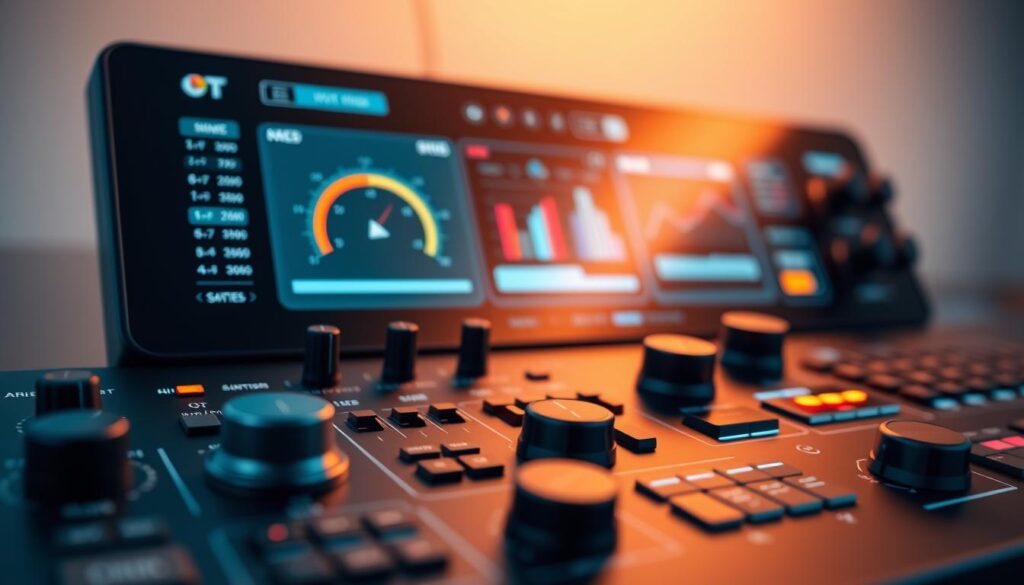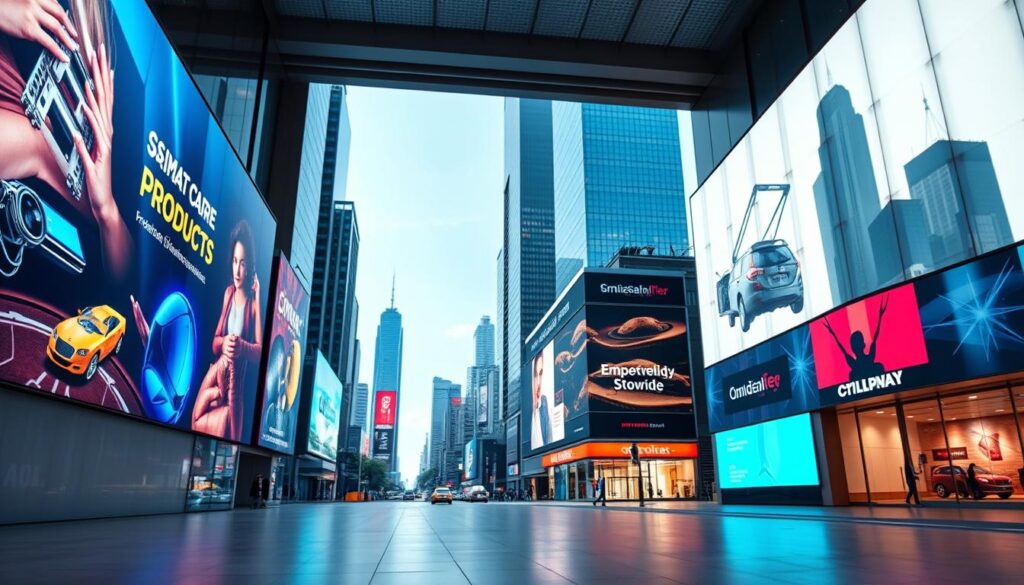Nearly $500 billion moved through automated digital media in 2022, and that scale is reshaping how elite brands grow. This shift is powered by AI and machine learning that buy impressions in real time to cut waste and speed profitable growth.
We build for leaders who need predictable scale. The modern process uses first-, second-, and third-party data to target the right audience at the right time. For high-ticket brands, this means tighter ROAS, lower cost per conversion, and clearer media accountability.
Rising CAC and fragmented channels are executive problems. Consolidating buys on a single platform reduces friction and gives advertisers centralized control over bids, pacing, and creative testing.
This Ultimate Guide maps strategy, platforms, costs, risks, and a step-by-step path to measurable return. If you want a proven playbook, we outline readiness checks and the route to Macro Webber’s Growth Blueprint or a consultation to engineer scalable growth.
Key Takeaways
- AI-driven automation now dominates large digital budgets and enables scale.
- Using data and machine intelligence buys better impressions at lower cost.
- Consolidated media buying reduces CAC and improves ROAS for premium brands.
- The guide covers platforms, costs, risks, and optimization frameworks.
- Macro Webber offers a proven path—book a consultation to evaluate readiness.
The shift to automation: why Programmatic Advertising matters right now
An automation wave is rewriting how elite brands reach customers in real time. Machines execute the buying flow that once required weeks of manual work, collapsing IO timelines into millisecond auctions.
What changed. The old process—direct deals, insertion orders, and agency handoffs—gave way to systems that transact across exchanges and measure attention instantly. This technology replaces slow approvals with nimble measurement and creative personalization.
Why leaders care. Automation shifts spend from process overhead to working media that drives revenue. For large brands, abundant first‑party data and rich creative libraries let machine learning improve outcomes fast.
- Speed: Faster test-and-learn cycles cut campaign ramp time.
- Scale: Centralized buying collapses fragmented channels into one way to reach the right audience.
- Control: Advertisers gain transparency and tighter budget pacing versus opaque, one-off deals.
Bottom line: With programmatic advertising powering most digital display, staying manual costs reach, precision, and efficiency. Early adopters lock in compounding ROI from smarter bids, premium video growth, and advanced deal types ahead of competitors.
Programmatic Advertising explained for decision-makers
We translate complex media science into clear decisions for executive teams. This section explains how automation converts signals into spend that drives profitable growth.
How AI and machine learning automate the media-buying process
AI models evaluate each impression and predict its chance to hit your KPI. The machine sets bids in milliseconds, using first-, second-, and third-party data to target across devices.
Control levers—frequency caps, exclusions, pacing, and creative rotation—are managed in a DSP interface. Verification and viewability layers enforce quality as you scale.
From manual IOs to automated exchanges: what changed and why it scales
Manual buying relied on RFPs, IOs, and one-off deals. Exchanges remove that friction and let advertisers reach thousands of sites instantly.
- Real-time auctions reduce waste and speed testing.
- Feedback loops refine audiences and bidding logic over time.
- Executives gain faster experimentation and clearer ROI paths.
Bottom line: The larger your data footprint and ambition, the more automation outperforms manual media, freeing teams to focus on strategy and high-return tactics.
Inside the programmatic ecosystem: DSPs, SSPs, DMPs, and ad exchanges
We map the ad tech stack so executives see where value and risk live. The market is a linked system: buyers, sellers, neutral exchanges, and verification partners. A clear map lets us design a stack that favors quality and ROI.

Buy side: demand-side platforms and data
On the buy side, advertisers access inventory through a dsp. A demand-side platform centralizes bid logic, creative, and budgets.
Data management platforms organize first-, second-, and third-party signals so targeting is precise and privacy-compliant.
Sell side: publishers and yield platforms
Publishers route their inventory to market via ssps and ad networks. This gives a publisher control over yield, floor prices, and deal types.
The exchange: the real-time marketplace
Exchanges connect DSP demand to SSP supply in milliseconds. Bid requests carry contextual and consented signals; the response returns the winning creative.
- Intermediaries: verification, MMPs, and clean rooms protect viewability, attribution, and privacy.
- Governance: allowlists, blocklists, and contextual controls reduce brand risk.
- Pathways: PMPs and direct programmatic deals offer premium access alongside open exchange inventory.
Outcome: the right platform mix minimizes fees, improves inventory quality, and accelerates profitable reach for high-value campaigns.
Real-time bidding and the impression-level auction, step by step
Every website visit invokes a tightly choreographed market where context and consent travel together and a decision is made in milliseconds.
Bid request to ad serve:
- User loads a page; the publisher sends a bid request to exchanges with contextual data and opted-in signals.
- An SSP runs the auction for that single impression and signals available inventory to buyer systems.
- DSPs compute a bid in real time based on campaign goals, guardrails, and historical signals.
- The highest valid bid wins; the ad is served and the impression is recorded.
What leaders need to know: second-price or first-price dynamics change clearing prices and bidding strategy. Controls like floor prices, frequency caps, and pacing protect delivery and ROI.
Every served ad becomes a measurable learning point. That feedback sharpens future bids and reduces waste. When scale needs placement control, pair RTB with PMPs to balance reach and premium access.
Types of programmatic channels and where your audience actually is
We map channel choices to where high-value buyers spend attention and money. This directs creative, measurement, and budget to the moments that move conversions.
Display, video, native
Display delivers efficient reach and scale for top-of-funnel goals. Use it to broaden awareness and remarket warm users.
Video drives storytelling and attention. Spend in video rose from about $62.96B in 2022 to a projected $74.88B in 2023, showing clear audience migration to sight and sound.
Native blends with content—use in-feed, in-article, and recommendation widgets for seamless engagement and higher CTRs.
Social, in-app, audio
Walled-garden social media can be stitched into demand stacks via APIs or DSP integrations for precise reach at scale.
In-app formats—bottom banners, interstitials, and rewarded units—avoid many blockers and capture mobile-first audiences in apps.
Audio works for contextual reach during commutes and routines where sight-based media can’t compete.
CTV and digital out-of-home (DOOH)
CTV reaches cord-cutters with premium, lean-back attention—ideal for upper-funnel storytelling and brand lift.
DOOH pairs creative with geofencing to meet customers along their physical journey. Use it for location-aware messaging and timely calls to action.
- Channel roles: display for reach, video for storytelling, native for engagement.
- Orchestration: prospect via video/native, nurture with display, close and retarget via CTV and in-app.
- Creative alignment: match format and measurement to the channel to maximize conversion potential.
Auction models and deals: open auction, PMP, preferred, guaranteed
Selecting the right market mechanism determines whether you win scale or certainty. We map four common paths so leaders choose by objective, risk tolerance, and placement needs.
When to use RTB for scale vs. PMPs for control
Open auction (RTB) delivers maximum reach and price efficiency. Use it for prospecting when advertisers want broad exposure and fast learning.
PMPs blend scale with publisher-level terms and safer inventory. Choose PMPs when brand safety, first-party data, and premium placements matter.
Guaranteed and preferred deals for premium inventory
Programmatic guaranteed secures fixed impressions and exact placement for mission-critical campaigns. It buys certainty at higher cost and longer negotiation time.
Preferred deals lock competitive rates and priority before inventory reaches the open exchange. They are faster to strike than guaranteed contracts.
- Risk trade-off: transparency and brand safety improve from open auction to guaranteed; costs and negotiation time rise.
- Decision rule: use RTB for reach, PMPs for sensitive placements, guaranteed for high-impact formats, preferred for rate certainty.
- Governance: require SLAs with publishers, fraud clauses, and delivery guarantees when buying premium space.
Programmatic costs and pricing models
Understanding how media is priced lets us align spend to growth targets with confidence.
Choose the model by objective. We map pricing to KPI: CPM for broad reach, CPC for measured engagement, and CPA when you must pay per conversion.
Why prices differ. Display formats usually carry lower rates; video commands higher fees because of attention and completion rates. Native and CTV sit between, rising with premium inventory and contextual value.
- CPM: common for reach and frequency buying.
- CPC: use when clicks and site actions matter.
- CPA: best for direct-response and conversion control.
Targeting specificity and audience size shape delivery and cost. Narrow, high-intent segments lift CPMs and can throttle impressions if scale is small. We caution against over-narrowing early in a campaign.
For budgeting, estimate needed CPMs, multiply by forecasted impressions and campaign duration, then add platform fees to compute effective cost. Test mixed models and optimize toward blended ROAS and CAC. Factor competition and seasonality into forecasts to protect pacing and maximize return.
The technology fee stack and transparency in your total ROI
Transparency in the fee stack separates vendors who add measurable value from those who simply extract margin. We itemize common charges so leaders can model true ROI and make clean decisions.
Common fees include DSP and SSP take rates, data fees, verification and measurement charges, and managed service markups. Each layer reduces the publisher revenue that turns into working media.
Hidden take rates distort benchmarks and mask true cost. We insist on log-level access and clean contracts so every dollar moves through an auditable process.
- Audit the stack: list DSP, SSP, data, verification, yield, and service fees.
- Value test: keep partners that demonstrably lift viewability, quality, or conversions.
- SPO: optimize supply paths to reduce hops and unnecessary fees while protecting inventory quality.
- Align incentives: use outcome-based SLAs and performance clauses to share upside.
Small shifts matter. Redirecting 10–20% from fees back into working media often lifts outcomes materially. We recommend a checklist audit and contractual changes before scaling buying or media spend.
Benefits that move the needle for high-ticket brands
High-ticket brands win when media systems turn data into measurable revenue fast. We align reach, precision, and velocity to enterprise KPIs: revenue, ROAS, speed, and efficiency.

Reach, precision targeting, and speed to market
We expand reach into premium audiences while keeping targeting surgical. That balance boosts high-value conversions and lifetime value.
Speed matters. Campaigns launch in days and iterate in hours, which shortens testing cycles and improves ROAS.
Mid-campaign optimization: CTR, CPC, conversions, and spend
We monitor CTR, CPC, CVR, and CPA in real time and reallocate budget where return is highest. For example, raising bids on a top-performing creative cut CPA by 18% in one quarter for a luxury client.
- Scale: 72% of digital display is programmatic, unlocking premium supply at scale.
- Agility: creative rotation, audience refinement, and budget shifts happen instantly.
- P&L impact: less non-working spend, higher media return, and faster path to profitability.
Outcome: cross-channel orchestration compounds learning. Over quarters, continuous optimization delivers durable lift and predictable growth for advertisers and their brands.
Risks and limitations: brand safety, fraud, and data privacy
Risk lives where scale meets complexity: unsafe placements, invalid traffic, and data misuse can erode brand trust and waste spend. We treat trust as a primary KPI and design controls that protect reputation while preserving reach.
Verification, measurement, and clean rooms
We require verification partners that ensure viewability, detect fraud, and enforce contextual safety. MMPs and attribution platforms deduplicate conversions and measure true reach and frequency.
Clean rooms let us match anonymized first-party signals with publishers and a platform without exposing raw PII. This preserves privacy while improving targeting and measurement.
GDPR/CCPA compliance and trust-first data practices
We codify consent, retention limits, and data minimization into every process. DSPs and partners must provide attestations and pass regular audits to prove compliance.
- Use allowlists, blocklists, and sensitive-content exclusions to shield your website and brand.
- Adopt tiered inventory strategies to balance protection with scale.
- Require partner reports and log-level access for transparent audits.
Outcome: a defensible, scalable way to run advertising that preserves brand equity and keeps advertisers in control.
Are you ready for Programmatic Advertising?
Before you commit budget, decide whether automated media aligns with your growth horizon and risk appetite. We offer a concise, executive-ready checklist to greenlight or plan adoption.
Readiness checklist: goals, data, creative, budget, and team
Define outcomes. Name the KPIs—awareness, leads, or sales—before any spend. Clear objectives set bidding logic and measurement from day one.
Assess data assets. Inventory first-party depth, consent frameworks, and integration paths into the DSP. Without clean signals, targeting and measurement break down quickly.
Audit creative. Confirm formats for display, video, native, CTV, and DOOH. Ensure rapid iteration and templates so ads rotate at scale.
- Model budgets: map audience size, duration, and required CPM to meet delivery targets.
- Clarify roles: strategy, trading, analytics, creative ops, and governance—assign owners.
- Validate the stack: DSP, measurement, verification, and clean room alignment are non‑negotiable.
- Design tests: phased pilots with success thresholds and go/no‑go triggers.
- Executive cadence: weekly readouts and monthly optimization councils to keep momentum.
“We insist on outcomes: measure everything, optimize fast, and only scale what proves profitable.”
Next step: run a 30‑ to 60‑day pilot that ties the budget to a single KPI and a named owner. That gives advertisers a clean window to evaluate the platform, the team, and the tools before scaling.
Choosing the right platforms and partners
A disciplined vendor selection process turns tools into measurable growth engines. We evaluate platforms and partners to align technology with commercial outcomes.
Evaluating DSPs, SSPs, DMPs/CDPs, and measurement partners
Start with must-haves: scale, premium inventory access, advanced optimization, and transparent fees. Insist on log-level access and clear commercial terms.
Due diligence checklist:
- Scale & supply: Which dsps and ssps deliver premium publisher access and competitive clearing prices?
- Data capabilities: Does the platform offer identity resolution, audience building, and clean room integrations?
- Measurement rigor: Is multi-touch attribution, incrementality testing, and log-level export available?
- Safety stack: Are verification integrations, contextual intelligence, and fraud prevention built in?
- UX & automation: Do tools offer rules, alerts, and AI-driven bid strategies for efficient buying?
- Stability & terms: What are the roadmap, support SLAs, performance SLAs, and exit clauses?
“Choose partners that prove ROI in a 30–60 day pilot, with outcomes and exit triggers written into the contract.”
| Partner Type | Core Question | Red Flag | Good Example |
|---|---|---|---|
| DSP | Does it match scale, optimization, and transparent fees? | Opaque fee overlays; no log access | Zemanta by Outbrain |
| SSP | Does it provide premium publisher access and competitive clearing? | Limited premium deals; high pass-through fees | Top-tier publisher SSP mix |
| DMP / CDP | Can it resolve identity and integrate clean rooms? | Poor match rates; no audit trail | Enterprise CDP with clean room links |
| Measurement | Is incrementality testing and log-level reporting supported? | Single-touch attribution only | Independent measurement partner |
Execution tip: Run a controlled pilot. Align commercial terms to outcomes, include test windows, performance SLAs, and clear exit clauses. That protects spend and accelerates confident scale.
Setting up your first campaign the right way
Set a clear commercial aim before the DSP is touched—clarity saves budget and time. We translate that aim into a campaign brief your team can execute in one pass.
Objective-setting, audience design, and creative formats
We lock objectives and KPIs, then map them to targeting and creative requirements. Use one primary KPI per flight to keep measurement clean.
We architect audiences as prospecting, retargeting, and consented lookalikes. Each audience has rules for frequency and exclusion.
Select formats by funnel: display and native for reach; video and CTV for depth; DOOH for contextual impact.
Bidding strategy, pacing, and budget estimation
After goals and ad types are set and the DSP is configured, calculate duration and audience size to estimate CPMs needed to win bids. Display typically has the lowest CPMs; video is highest.
We define bidding logic: floors, bid ranges, and guardrails by deal type and channel. Design pacing as even or accelerated with safeguards for learning and peak windows.
“Estimate budget from audience size, target frequency, and expected CPMs; instrument alerts to pivot spend fast.”
| Duration | Expected CPM | Pacing | Primary Metric |
|---|---|---|---|
| 2 weeks | $4–$8 | Accelerated | Impressions |
| 30 days | $6–$12 | Even | CTR / CPC |
| 90 days | $10–$25 | Even with peaks | Conversions / ROAS |
- Prebuild creative variants for rapid A/B tests and fatigue mitigation.
- Instrument mid-campaign reporting on CTR, CPC, spend, and conversions to optimize toward profit.
- Audit inventory and website placements to protect brand space and manage cost.
Measurement that matters: from attention to outcomes
Executives need metrics that connect exposure to real business outcomes. We focus on signals that predict revenue, not vanity counts.
KPIs to prioritize for each stage
Quality exposure: measure viewability and attention time before engagement. These show whether impressions are meaningful.
Engagement: track CTR and CVR to see creative and audience fit. Use CPA and ROAS to tie engagement to profit.
Outcomes: monitor conversions, average order value, and incremental lift to prove that ads drive commercial return.
Executive dashboard and testing rules
We require deduplicated, privacy-safe measurement that reports true reach and frequency. Attribution must support cohort analysis and path-to-conversion insights.
“Prioritize attention and incremental lift—those predict long-term return better than clicks alone.”
| Metric | Why it matters | Target (Prospecting) | Target (Retargeting) |
|---|---|---|---|
| Impressions | Scale and reach baseline | High volume | Controlled, frequency-capped |
| Viewability / Attention | Quality exposure that precedes engagement | >50% viewable; attention >2s | >70% viewable; attention >3s |
| CTR / CVR | Creative and audience effectiveness | CTR 0.3%–0.7% / CVR 1%–2% | CTR 1%–3% / CVR 3%–8% |
| ROAS / Incremental Lift | Direct business return and causality | ROAS ≥ target; positive incremental lift | Higher ROAS; demonstrable lift vs. control |
Process rules: run randomized tests, validate causality with holdouts, and reallocate budget weekly based on cohort trends. We present concise weekly dashboards for advertisers that show spend, AOV, ROAS, and reallocation cues.
Optimization playbook powered by machine learning
Optimization is a continuous loop: test, learn, and scale where data proves profit. We apply that discipline across creative, audiences, and deals so every dollar moves toward measurable return.
Start with goals. Configure algorithmic bid strategies aligned to conversion and ROAS targets. Most DSP dashboards provide real-time reporting and alerts; we use that visibility to act within the same hour.
A/B testing, frequency caps, dayparting, and bid modifiers
We systematize A/B tests for creative and audience sets so the best-performing ads win more exposure. Frequency caps protect margins and the user experience.
Dayparting and geo-modifiers align spend to peak response windows. The machine refines bidding logic by device, inventory quality, and deal type.
Using real-time reporting to iterate toward profitability
Set alerts for anomalies and automate budget moves to winners. Integrate predictive attention signals—Outbrain’s example improved viewability and CTR by bidding on likely viewable impressions.
“Run weekly optimization sprints guided by data and automated insights.”
- Algorithmic bidding tuned to KPI
- Systematic A/B testing across formats
- Real-time alerts and hourly pivots
| Lever | Action | Outcome |
|---|---|---|
| Bidding | Algorithmic bid rules; device modifiers | Higher conversion win rate |
| Creative | Rapid A/B cycles; rotate top ads | Improved CTR and CVR |
| Scheduling | Dayparting and geo-targets | Lower wasted spend; better ROAS |
Current trends shaping programmatic in the United States
Today’s media mix requires AI that anticipates behavior and creative that earns attention. We see four forces reshaping U.S. markets: predictive models, mobile-first spend, premium video growth, and context-rich out-of-home execution.
AI-driven prediction, mobile-first spend, and premium video growth
AI and machine learning now tune bids, pacing, and creative in real time. That raises efficiency and reduces waste across exchanges and inventory.
Mobile dominates: about 75.6% of U.S. digital display spend is mobile. That shifts budgets into apps and social media placements where cross-device identity matters.
Premium video and CTV expand storytelling with measurable attention metrics and outcome-focused buys that link to revenue, not just reach.
DOOH geofencing and outcome-based buying
DOOH plus geofencing blends physical context with digital audience signals. It creates omnichannel touchpoints that lift conversion when tied to online cohorts.
We recommend: strengthen first-party data, adopt clean rooms, and prioritize supply-path optimization to secure quality marketplaces and durable scale.
“Lead with outcomes: align bids to business metrics, not vanity counts.”
| Trend | Implication | Action |
|---|---|---|
| AI prediction | Higher bid efficiency | Deploy ML-backed bidding and test attention signals |
| Mobile-first spend | In-app & social media focus | Invest in identity solutions and cross-device measurement |
| Premium video / CTV | Brand storytelling + measurable lift | Prioritize viewability and outcome-based deals |
| DOOH + geofencing | Contextual omnichannel reach | Sync geotargets with digital cohorts and outcome KPIs |
Conclusion
A clear ROI-first approach turns complex ad stacks into reliable growth engines.
We recap the business case: precision at scale, faster learning, and measurable growth across platform and media. Align goals, first-party data, creative, team, and governance to win the audience moments that matter.
Protecting brand and ROI requires transparency in fees, strict safety controls, and privacy-first processes. That governance is non-negotiable for elite advertisers.
Act now. Unlock Macro Webber’s Growth Blueprint and the WebberXSuite™ with the A.C.E.S. Framework—built to engineer future-proof growth. Book a 30-minute executive consult to model your ROI. Limited onboarding slots preserve performance rigor and partner focus.
We design, measure, and scale results. Join the brands that lead.



